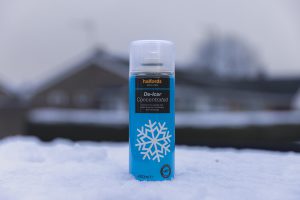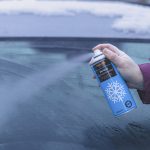There’s a lot to think about when it comes to winter driving – from wiper blades and bulbs to new tyres and screenwash, getting ready for the changing weather can be tough.
But what do you do when you can’t even unlock your car? If your car lock or even the whole door is frozen shut, we’re here to help. In this blog, we’ll guide you through how to get your car open again, and how to prevent it from freezing in the first place.

Why do car locks freeze?
There are a few reasons why your lock – or even the door itself – might freeze.
Dirt inside your door frame
Your car doors are sealed by a strip of rubber, which keeps your vehicle secure and watertight. If you allow dirt to build up and around the seal, it can prevent the door from sealing properly, allowing moisture in. As the temperature drops overnight, that moisture will turn to ice and cause your door to freeze shut.
Water in your lock
If the lock itself is frozen, it’s likely because water or moisture has gotten inside the mechanism and frozen as the temperature has dropped.
Not lubricating often enough
There are plenty of common car problems that can be avoided with some regular maintenance, and an area that we often don’t think taking care of is our locks. Just like any other part of your vehicle, locks require regular care. Applying a dry graphite lubricant to your key and inserting it into the lock helps to create a protective layer, which reduces the chance of water entering the lock and freezing in cold temperatures.
How to prevent car locks from freezing
A frozen car door lock on a cold morning is not ideal, so how do you stop it from happening in the first place? Here are our tips.
Don’t let locks and door seals become dirty
It’s not an area we often think about cleaning, but making sure there isn’t a build-up of dirt inside the locking mechanism or the door seal will help to keep them free of moisture. Dirt and debris will stop the door from forming a watertight seal, allowing moisture to freeze overnight and seize the door shut.
Keeping rust and dirt away from your locks will help to prevent them from freezing too. Some WD-40 will work well – just be sure to wipe it off your paintwork if you make a mess.
Check your seals aren’t damaged
In the same way, damaged seals will let moisture in too so keep an eye out for signs of wear and replace worn-out seals as soon as possible to keep water out.
Park away from the elements
Ultimately, the way to keep your car from freezing is to protect your car from bad weather and low temperatures if you can. Parking in a garage, underneath a car port, or even using a car cover can help prevent any freezing.
How to open frozen car door locks
Using a small amount of de-icer can quickly melt the ice inside the lock since it contains alcohol. You can apply the de-icer to your key if it’s easier, and you might need to gently move your key inside the lock to work it into the mechanism. You could also try warming the key in the palm of your hand first.
As for the door seal, try pushing into the door, as if you’re shutting it. This should break up some of the ice without putting strain on your handle. Some de-icer might also do the trick sprayed around the edge of your door – most modern de-icers won’t do any damage to your paintwork.

What not to do if your car lock freezes
There are plenty of online hacks and common tricks for melting ice that’s freezing your door or lock, but a lot of them can end up doing far more damage to your car. Here are some hacks to avoid:
• Don’t pull at the door handle: If the seal is frozen, you risk tearing the rubber or breaking the handle itself
• Don’t try to force your key into the lock: Without proper lubrication, you could easily snap the key in the lock
• Don’t heat your key with a flame: Doing this risks damaging the key itself or the computer chip inside.
• Never use hot water: Just like melting your windscreen, you should never pour hot water into your lock or around your door seal. The thermal shock will only damage your car and make things worse.


